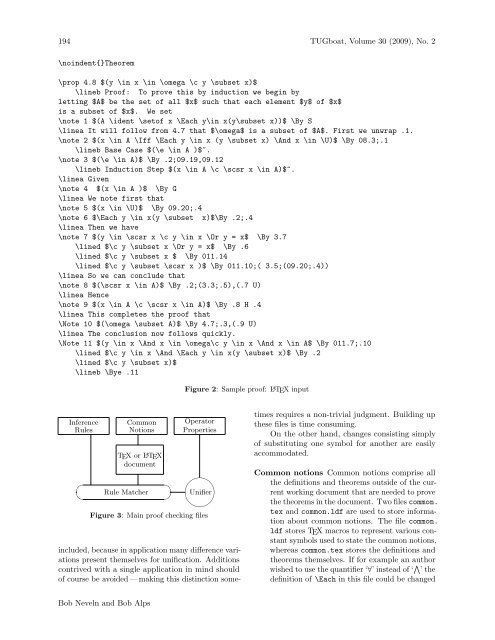The Communications of the TEX Users Group Volume 30 ... - TUG
The Communications of the TEX Users Group Volume 30 ... - TUG
The Communications of the TEX Users Group Volume 30 ... - TUG
Create successful ePaper yourself
Turn your PDF publications into a flip-book with our unique Google optimized e-Paper software.
194 <strong>TUG</strong>boat, <strong>Volume</strong> <strong>30</strong> (2009), No. 2<br />
\noindent{}<strong>The</strong>orem<br />
\prop 4.8 $(y \in x \in \omega \c y \subset x)$<br />
\lineb Pro<strong>of</strong>: To prove this by induction we begin by<br />
letting $A$ be <strong>the</strong> set <strong>of</strong> all $x$ such that each element $y$ <strong>of</strong> $x$<br />
is a subset <strong>of</strong> $x$. We set<br />
\note 1 $(A \ident \set<strong>of</strong> x \Each y\in x(y\subset x))$ \By S<br />
\linea It will follow from 4.7 that $\omega$ is a subset <strong>of</strong> $A$. First we unwrap .1.<br />
\note 2 $(x \in A \Iff \Each y \in x (y \subset x) \And x \in \U)$ \By 08.3;.1<br />
\lineb Base Case $(\e \in A )$~.<br />
\note 3 $(\e \in A)$ \By .2;09.19,09.12<br />
\lineb Induction Step $(x \in A \c \scsr x \in A)$~.<br />
\linea Given<br />
\note 4 $(x \in A )$ \By G<br />
\linea We note first that<br />
\note 5 $(x \in \U)$ \By 09.20;.4<br />
\note 6 $\Each y \in x(y \subset x)$\By .2;.4<br />
\linea <strong>The</strong>n we have<br />
\note 7 $(y \in \scsr x \c y \in x \Or y = x$ \By 3.7<br />
\lined $\c y \subset x \Or y = x$ \By .6<br />
\lined $\c y \subset x $ \By 011.14<br />
\lined $\c y \subset \scsr x )$ \By 011.10;( 3.5;(09.20;.4))<br />
\linea So we can conclude that<br />
\note 8 $(\scsr x \in A)$ \By .2;(3.3;.5),(.7 U)<br />
\linea Hence<br />
\note 9 $(x \in A \c \scsr x \in A)$ \By .8 H .4<br />
\linea This completes <strong>the</strong> pro<strong>of</strong> that<br />
\Note 10 $(\omega \subset A)$ \By 4.7;.3,(.9 U)<br />
\linea <strong>The</strong> conclusion now follows quickly.<br />
\Note 11 $(y \in x \And x \in \omega\c y \in x \And x \in A$ \By 011.7;.10<br />
\lined $\c y \in x \And \Each y \in x(y \subset x)$ \By .2<br />
\lined $\c y \subset x)$<br />
\lineb \Bye .11<br />
Inference<br />
Rules<br />
Common<br />
Notions<br />
Figure 2: Sample pro<strong>of</strong>: L A<strong>TEX</strong> input<br />
Operator<br />
Properties<br />
<strong>TEX</strong> or LA<strong>TEX</strong> document<br />
★✥<br />
✎<br />
☞<br />
Rule Matcher Unifier<br />
✍<br />
✌<br />
✧✦<br />
Figure 3: Main pro<strong>of</strong> checking files<br />
included, because in application many difference variations<br />
present <strong>the</strong>mselves for unification. Additions<br />
contrived with a single application in mind should<br />
<strong>of</strong> course be avoided—making this distinction some-<br />
Bob Neveln and Bob Alps<br />
times requires a non-trivial judgment. Building up<br />
<strong>the</strong>se files is time consuming.<br />
On <strong>the</strong> o<strong>the</strong>r hand, changes consisting simply<br />
<strong>of</strong> substituting one symbol for ano<strong>the</strong>r are easily<br />
accommodated.<br />
Common notions Common notions comprise all<br />
<strong>the</strong> definitions and <strong>the</strong>orems outside <strong>of</strong> <strong>the</strong> current<br />
working document that are needed to prove<br />
<strong>the</strong><strong>the</strong>oremsin<strong>the</strong>document. Tw<strong>of</strong>ilescommon.<br />
tex and common.ldf are used to store information<br />
about common notions. <strong>The</strong> file common.<br />
ldf stores <strong>TEX</strong> macros to represent various constant<br />
symbols used to state <strong>the</strong> common notions,<br />
whereas common.tex stores <strong>the</strong> definitions and<br />
<strong>the</strong>orems <strong>the</strong>mselves. If for example an author<br />
wished to use <strong>the</strong> quantifier ‘∀’ instead <strong>of</strong> ‘ � ’ <strong>the</strong><br />
definition <strong>of</strong> \Each in this file could be changed

















